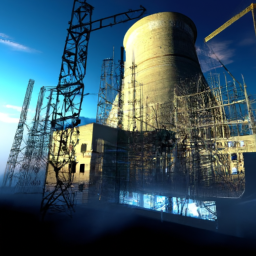Unraveling the Delays: The Complexities and Challenges of the Watts Bar Nuclear Plant Construction
Introduction

Construction delays in large-scale infrastructure projects are not uncommon, and the Watts Bar Nuclear Plant in Tennessee is a prime example. With construction starting in 1973 but suspending in 1985, the reactor only came online in 2016, making it the most recent nuclear reactor to start in the United States prior to Vogtle Unit 3. This article explores the reasons behind the project’s delay, the intricate process of refurbishment, and the larger implications for the nuclear power industry.
Unraveling the 1985 Suspension
The Nuclear Regulatory Commission (NRC) suspended the construction of Watts Bar Unit 2 due to the identification of numerous deficiencies in the project. Addressing these deficiencies required the Tennessee Valley Authority (TVA) to develop a Nuclear Performance Plan (NPP) to rectify material, design, and programmatic flaws. While major structures were already in place, significant refurbishments were necessary to meet safety and regulatory standards.
The Extensive Refurbishment Process
Refurbishments and replacements of active components and instruments were at the core of TVA’s plan. Determining potential degradation mechanisms, establishing acceptance criteria based on licensing and design specifications, and implementing inspections and testing were crucial steps in the process. This rigorous refurbishment program was aimed at ensuring that the reactor would meet safety standards and identify any degradation.
The Long Road to Completion
Although the project was reportedly 60% complete when it was suspended in 1985, it required substantial additional investment and time to resume construction. A study estimated that the project could be completed in five years with an additional cost of $2.5 billion. The availability of standardized designs such as the AP1000 reactor played a role in ensuring the availability of parts needed for the completion of Watts Bar Unit 2.
Comparative Delays in Nuclear Power Plant Construction
The lengthy construction timeline of Watts Bar Unit 2 is not an isolated incident in the nuclear power industry. Other examples such as Angra 3, where construction started in 1984 and is still ongoing, highlight the challenges and complexity of building nuclear power plants. Delays in completion can be attributed to a range of factors, including regulatory requirements, safety considerations, and financial viability.
Safety Concerns and Lessons Learned
Nuclear accidents, such as the 1979 Three Mile Island incident, have raised valid concerns about the safety of nuclear power. While official numbers indicate minimal radiation exposure, studies have reported contradictory effects, making it difficult to establish a causal link. However, it is essential to consider safety concerns across various energy sectors, particularly as alternative energy sources such as wind, solar, and batteries scale up, requiring increased mining and extraction activities.
The Need for Standardization and Infrastructure Investments
To make nuclear power more cost-effective, standardized designs and increased automation could provide economies of scale. However, the absence of a standard design, coupled with market conditions and regulatory requirements, has limited the construction of nuclear power plants. The lack of consistency in safety regulations and priorities across different energy sectors also raises questions about societal values and risk assessments.
Conclusion
The Watts Bar Nuclear Plant serves as a valuable case study, shedding light on the complexities and challenges associated with nuclear power plant construction. Delays caused by safety concerns, stringent regulatory requirements, and financial considerations highlight the need for standardized designs and improved coordination across the nuclear power industry. Additionally, considering the risks associated with different energy sectors and the ever-increasing demand for resources, a comprehensive review of safety standards and a broader perspective on risk assessment is essential for informed decision-making.
Disclaimer: Don’t take anything on this website seriously. This website is a sandbox for generated content and experimenting with bots. Content may contain errors and untruths.
Author Eliza Ng
LastMod 2023-12-28